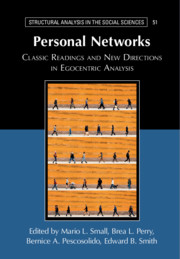Introduction
from I - Background
Published online by Cambridge University Press: 01 October 2021
Summary
Network analysis is ubiquitous. It has shaped how researchers and society as a whole understand issues as diverse as the spread of disease, the precursors of loneliness, the rise of protest movements, the causes of social inequality, the flows of air traffic, the rise of social media, and much more (McAdam and Paulsen 1993; Wasserman and Faust 1994; Watts and Strogatz 1998; Watts 1999; Barabási 2002; Christakis and Fowler 2009; Wellman et al. 2021).1 This influence is due to the remarkable flexibility and power of network analysis. A network is simply a set of nodes and the ties between them, and a node can be anything – an individual, an organization, a website, a computer server, an airport, a nation, or any entity with the capacity to connect in any fashion to another entity. The ability to think of any relationship in network terms has proved remarkably generative for researchers.
- Type
- Chapter
- Information
- Personal NetworksClassic Readings and New Directions in Egocentric Analysis, pp. 3 - 26Publisher: Cambridge University PressPrint publication year: 2021
References
- 2
- Cited by

